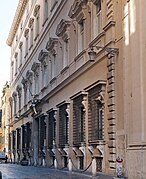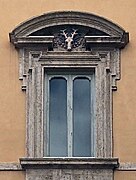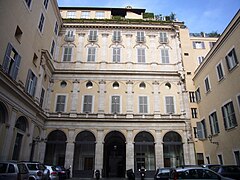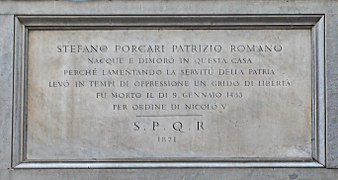Palazzo Maffei Marescotti
| Palazzo Maffei Marescotti | |
|---|---|
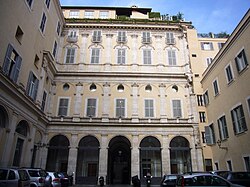 Arcaded courtyard |
|
| Data | |
| place | Rome , Via della Pigna 13a |
| architect | Giacomo della Porta |
| Client | Cardinal Marcantonio Maffei |
| Architectural style | Baroque |
| Construction year | 1577 or 1865 |
| Coordinates | 41 ° 53 '48.6 " N , 12 ° 28' 39.7" E |
| particularities | |
| Extra-territorial possession of the Holy See | |
The Palazzo Maffei Marescotti , also known as Palazzo Estense or Vecchio Vicariato , is a large noble palace in Rome in the Pigna district . It is located between Via dei Cestari and Via della Pigna in the immediate vicinity of the Basilica of Santa Maria sopra Minerva and the Pantheon . Since 1906 it has been part of the extraterritorial possessions of the Holy See.
history
On behalf of Cardinal Marcantonio Maffei, the Roman architect Giacomo della Porta designed the current building around 1580 and had some of the houses of the noble Porcari family demolished, who had had some residences in the vicinity of the current palace since 1468 at the latest. Cardinal Maffei died in 1583 and left the building unfinished.
The palazzo then experienced an eventful history from many successive owners: in 1591 a nephew of the deceased cardinal sold the palace to Camilla Peretti, a sister of Pope Sixtus V. In 1605, Camilla Peretti entered the still unfinished building for 29,000 scudi to the Marchese Clemente Sannesio de Calutiis from. In 1621 the building changed hands again and went to the nephew Pope Gregory XV. , the Cardinal Ludovico Ludovisi . He commissioned the architect Gaspare de Vecchi with expansion work, but died before they could begin. In 1668, Duke Francesco II. D'Este bought the palace for 40,000 Scudi and appointed the architect Mattia de Rossi for further construction work. After Francesco's death, he was inherited by his uncle, Cardinal Rinaldo d'Este . In the possession of the Estonians, extensive work was carried out in the piano nobile , as well as a stable for 24 horses and three storage rooms for the bodies. In 1714 the palace passed to the Marchese Ottaviano Accaioli. In 1746 Count Orazio and Monsignor Alessandro Marescotti purchased the palace for 56,000 Scudi and entrusted Ferdinando Fuga with the extension of the building. The palace remained in the possession of the Marescotti family for more than a century. In 1865 it was sold to the Banca Romana for 75,000 scudi . The architect Antonio Sarti gave the building its present form in the same year.
In 1906 the Holy See acquired the palace and made it the seat of the diocesan curia (or Vicariato di Roma). Since the Lateran Treaty was signed in 1929, the building has had extraterritorial status and is exempt from expropriation and taxes. Today the Vicariato has its seat in the Lateran Palace , but the Palazzo Maffei has retained the name Vecchio Vicariato and the privileges. Various Catholic organizations are currently housed, including the Roman Pilgrimage and Catholic Action .
In 2014 marble fragments of the Forma Urbis Romae , an ancient city map of Rome from the 3rd century AD, were found during construction work .
description
The imposing structure has three floors. Baroque elements are added to the structure, which originally dates back to the 16th century. The mighty portal in Via della Pigna, bordered by half columns, is offset to the left; it shows a dog's head with a garland above the lintel. The aedicules on the windows of the three floors are remarkable, in the Piano Nobile they are alternately triangular and round. On the second floor they each show a deer head, the Maffei's heraldic animal. The deer head can also be seen in the cornice. The large inner courtyard dates from the 16th century. Its entrance side is divided into five arches accentuated by pilasters, which continue to the second floor. The original loggia on the first floor was subsequently closed, and in the 18th century a further floor with windows and small balconies was added to the second floor.
photos
Literature and Sources
- Paolo Coen: Le magnificenze di Roma nelle incisioni di Giuseppe Vasi , Newton & Compton Editori, Roma 2006, ISBN 978-88-541-0748-9 , p. 127 ff.
- Claudio Rendina: Palazzi Storici di Roma , Newton & Compton, Roma 2005, ISBN 88-541-0444-2 , p. 224 ff.
Remarks
- ↑ Above the entrance of the still preserved palace in Vicolo delle Ceste, a marble plaque commemorates the most famous resident of the house, the politician and humanist Stefano Porcari .
- ↑ Official Gazette del Regno dItalia; June 5, 1929, Appendix II. Plate 11
- ↑ The Roman patrician Stefano Porcari was born in this house and lived here. Because he lamented the enslavement of his homeland, he cried out for freedom in times of oppression. He was born on January 9, 1453 by order of Nicholas V executed. - SPQR 1871
Web links
- Map of the extraterritorial areas of the Holy See in OpenStreetMap
- List of extraterritorial areas of the Holy See (ital.)
- Marcantonio Maffei in catholic-hierarchy
- Palazzo Maffei Marescotti in archInform
- Palazzo Maffei Marescotti in myvisita.it (ital.)
- Palazzo Maffei Marescotti - Engraving by Vasi in romeartlover.it


